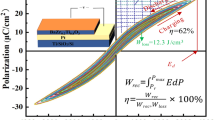Abstract
The ferroelectric properties of Nb-doped PZT thin films prepared by a sol-gel method were evaluated relative to memory device application requirements. Within the range of 0 to 4 mol %, Nb-doping of PZT compositions near the morphotropic phase boundary region (i.e. PZT 53/47) enhanced overall ferroelectric properties by reducing the te-tragonal distortion of the unit cell. A 4 mol % Nb-doped PZT 53/47 thin film (0.26 μm) had a coercivity of 8 V/ μm, a remanence ratio of 0.54, a switchable polarization of 45 μC/cm2, and a specific resistivity of 3 x 109 Ω-cm. Nb-doping levels in excess of 5 mol had a detrimental effect on the resulting thin film ferroelectric properties. X-ray diffraction (XRD) analysis of highly doped films showed development of a significant PbO phase accompanied by diffraction line broadening of the perovskite phase. As such, it was postulated that the creation of excessive lead vacancies in the PNZT lattice resulted in PbO accumulation at the grain boundaries which impeded grain growth, and hence, adversely affected ferroelectric switching performance. The fatigue performance of the sol-gel derived thin film capacitor system was a function of switching voltage. At switching fields sufficient to saturate the polarization, the endurance of the thin film capacitor was greater than 109 cycles. Cycling with lower fields reduced endurance values, but in all cases, the switchable polarization decreased linearly with the logarithm of cycles. Nb-doping did not have a significant effect on the fatigue performance.
Similar content being viewed by others
References
D. Bondurant and F. Gnadinger, IEEE Spectrum,30 July (1989).
B. Jaffe, W. R. Cook and H. Jaffe, Piezoelectric Ceramics, Academic Press, London, GB (1971).
T. B. Weston, A. H. Webster and V. M. McNamara, J. Can. Ceram. Soc.36, 15 (1967).
J. Fukushima, Yogyo Kyoaishi83, 204 (1974).
C. Chen, D. F. Ryder, Jr. and W. A. Spurgeon, J. Am. Cer. Soc.72, 1495 (1989).
J. Fukushima, K. Kodaira and T. Marsushita, J. Mater. Sci.19, 595 (1984).
K. D. Budd, S. K. Dey and D. A. Payne, Br. Ceram. Proc.36, 107 (1985).
S. R. Gurkovitch and J. B. Blum, “Preparation of Monolithic Lead Titanate by a Sol-Gel Process,” Ch. 12 in Ultrastructure Processing of Ceramics, Glasses, and Composites, eds. L. L. Hench and D. R. Ulrich, Wiley-Interscience, New York, NY 1984.
G. Yi, Z. Wu and M. Sayer, J. Appl. Phys.64, 2717 (1988).
W. H. Shepherd, Mat. Res. Soc. Symp. Proc, vol 200, pp 277–288, eds. E. R. Meyers and A. I. Kingon, (1990).
D. J. Johnson, D. T. Amm, E. Griswold, K. Sreenivas, G. Yi and M. Sayer, Mat. Res. Soc. Symp. Proc., vol 200, pp 289–295, eds. E. R. Meyers and A. I. Kingon, (1990).
Author information
Authors and Affiliations
Rights and permissions
About this article
Cite this article
Ryder, D.F., Raman, N.K. Sol-Gel processing of Nb-doped Pb(Zr, Ti)O3 thin films for ferroelectric memory applications. J. Electron. Mater. 21, 971–975 (1992). https://doi.org/10.1007/BF02684205
Received:
Revised:
Issue Date:
DOI: https://doi.org/10.1007/BF02684205




